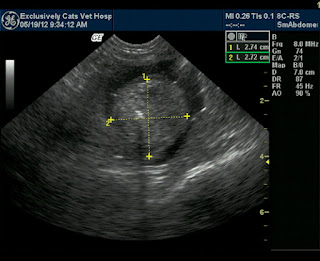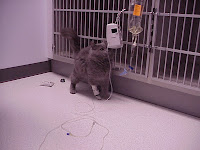 |
| The Lovely Cat by Sara Yard |
The mild winter and warm spells this spring mean that if you have a garden, it is probably in full bloom! As people spend more time outdoors in the summer, they are tempted to bring their cats outside with them. If you follow our blog, you already know about some of the toxic plants in the garden, and the ASPCA has a fairly comprehensive list of poisonous plants. However, you might want to know about some of the pet-friendly plants that you can add to your garden.
Some of the safest, pet-friendly plants you can choose include:
Astilbe, Bee Balm, Begonia, Catmint/Catnip, Coleus, Columbine, Coneflowers (Echinacea), Coral Bells, Cosmos, Impatiens, Nasturtium, Petunia, Phlox, Primrose, Roses, Snapdragons, and Zinnia
Other, non-plant concerns in the garden that you may not be aware of include: fertilizers, pesticides, slug
bait, mulch, and garden tools. Read labels carefully and do not allow pets in areas treated with non-pet-safe chemicals until a safe amount of time has passed. If you have your lawn professionally treated, ask your lawn care provider when your pets can safely be on the lawn after treatment. Store lawn and garden supplies safely in
sealed containers, cupboards or otherwise out-of-reach.
Natural products such as vinegar to help control weeds, coffee grounds, beer, and salt for slugs, and soap and water as a natural pesticide can be used instead of unsafe chemicals. Avoid cocoa mulch as it comes from chocolate manufacturing and can contain substances that will cause minor chocolate poisoning (vomiting, diarrhea, hyperactivity) as well as general irritation to the mouth, stomach and intestines.
Cats, in general, tend to be selective about what the eat. They might sniff, but they're
not inclined to eat plants. Kittens, however, love to play with just about anything much more than adult cats and will explore with their mouths! Keep this in mind if it has been a while since you have had a kitten in your yard, and look around with an educated eye.
Grass may be an exception to this rule, and while common grasses are safe you may find that you also want to plant some oat or wheat grass in a patch for your cat to enjoy. Many of the flashier ornamental grasses can be irritating to the mouth, throat, and nose so it would be wise to avoid these plants if your cat enjoys grasses.
Another consideration when letting your cats outside is that they should wear a break-away collar with ID tags, or better yet, have a microchip implanted. The majority of lost cats that become "found cats" are not microchipped, which makes it extremely difficult to locate the owner. If you have ever read any of the happy stories about microchipped pets being reunited with their owners, sometimes the pets are found hundreds of miles from their homes. With a microchip, you have added insurance that if your cat loses its collar and is taken to a veterinary hospital or animal shelter, it will be more likely to be identified. If your pet is microchipped, make sure to keep your address and phone number current in the microchip registry.
Another important thing to remember when allowing your pet to enjoy the garden with you is that while outside, your pet is exposed to parasites - fleas, heartworms, and various intestinal parasites. Even if your pet spends only a tiny amount of time outside, or only goes on the patio, there is a risk, so monthly heartworm preventive and diligent checks for fleas or monthly flea preventives are important.It is also important to have a stool sample checked for intestinal parasites on an annual or semi-annual basis, depending on whether your cat is a known hunter or not.
Because of the mild winter, this summer is expected to have larger than usual parasite populations, so if you have not given your pet monthly parasite preventives in the past, you may want to consider starting this year. If you need a refill on heartworm preventive for the summer, please call Exclusively Cats Veterinary Hospital at 248-666-5287, or place an order online through VetSource and let us know!
More about gardening for cats
Our Happy Cat Garden Tips
Pet friendly gardens
ASPCA Pet Safe Garden tips
Herbs that are Toxic to Cats (Listed by effect) *note - while lavender is not considered to be toxic while growing in the garden, concentrated lavender oil used in herbal remedies, while not deadly, can have toxic side effects.
Some of the safest, pet-friendly plants you can choose include:
Astilbe, Bee Balm, Begonia, Catmint/Catnip, Coleus, Columbine, Coneflowers (Echinacea), Coral Bells, Cosmos, Impatiens, Nasturtium, Petunia, Phlox, Primrose, Roses, Snapdragons, and Zinnia
 |
| Enjoying valerian at theGardenFairie.com |
Natural products such as vinegar to help control weeds, coffee grounds, beer, and salt for slugs, and soap and water as a natural pesticide can be used instead of unsafe chemicals. Avoid cocoa mulch as it comes from chocolate manufacturing and can contain substances that will cause minor chocolate poisoning (vomiting, diarrhea, hyperactivity) as well as general irritation to the mouth, stomach and intestines.
 | |
| Catnip! Yum! |
Grass may be an exception to this rule, and while common grasses are safe you may find that you also want to plant some oat or wheat grass in a patch for your cat to enjoy. Many of the flashier ornamental grasses can be irritating to the mouth, throat, and nose so it would be wise to avoid these plants if your cat enjoys grasses.
Another consideration when letting your cats outside is that they should wear a break-away collar with ID tags, or better yet, have a microchip implanted. The majority of lost cats that become "found cats" are not microchipped, which makes it extremely difficult to locate the owner. If you have ever read any of the happy stories about microchipped pets being reunited with their owners, sometimes the pets are found hundreds of miles from their homes. With a microchip, you have added insurance that if your cat loses its collar and is taken to a veterinary hospital or animal shelter, it will be more likely to be identified. If your pet is microchipped, make sure to keep your address and phone number current in the microchip registry.
Another important thing to remember when allowing your pet to enjoy the garden with you is that while outside, your pet is exposed to parasites - fleas, heartworms, and various intestinal parasites. Even if your pet spends only a tiny amount of time outside, or only goes on the patio, there is a risk, so monthly heartworm preventive and diligent checks for fleas or monthly flea preventives are important.It is also important to have a stool sample checked for intestinal parasites on an annual or semi-annual basis, depending on whether your cat is a known hunter or not.
Because of the mild winter, this summer is expected to have larger than usual parasite populations, so if you have not given your pet monthly parasite preventives in the past, you may want to consider starting this year. If you need a refill on heartworm preventive for the summer, please call Exclusively Cats Veterinary Hospital at 248-666-5287, or place an order online through VetSource and let us know!
More about gardening for cats
Our Happy Cat Garden Tips
Pet friendly gardens
ASPCA Pet Safe Garden tips
Herbs that are Toxic to Cats (Listed by effect) *note - while lavender is not considered to be toxic while growing in the garden, concentrated lavender oil used in herbal remedies, while not deadly, can have toxic side effects.










